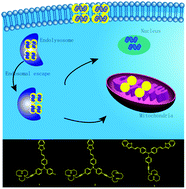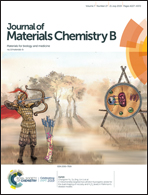Mitochondria targeting two-photon fluorescent molecules for gene transfection and biological tracking†
Abstract
Three new D–π–A type dyes 1–3 comprising triphenylamine as the core and [12]aneN3 or benzothiazole (Bz) as branches were designed as two-photon luminescent non-viral gene vectors with tracking ability. Compound 1 with one Bz and one [12]aneN3 branches as well as a heavy atom, I, has higher toxicity and lower transfection efficiency. Compound 2 containing two [12]aneN3 branches shows a good mitochondria targeting property and can condense DNA at 5 μM, in particular it exhibits 1.70 times higher red fluorescent gene (RFG) transfection efficiency than Lipofectamine 2000 in the presence of cell penetrating peptides (CPPs). Compound 3 with two Bz-branches and one [12]aneN3 moiety shows the largest two-photon absorption cross section of 309 GM at 760 nm among the three dyes and is able to localize in mitochondria with an overlap coefficient of 0.99. With the advantages of strong two-photon absorption, good DNA condensation, and mitochondria targeting ability, compound 2 was used to monitor the process of cellular uptake, DNA translocation and release, RFG expression in cells, and RFG expression in a rat tumor using a two-photon microscope. To the best of our knowledge, this study represents the first example of a mitochondria targeting two-photon fluorescent organic molecule in gene transfection in vitro and in vivo.



 Please wait while we load your content...
Please wait while we load your content...